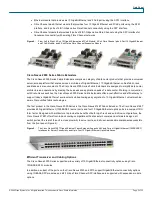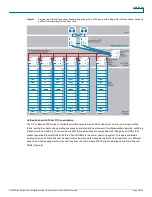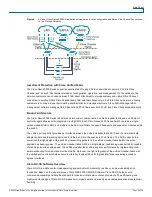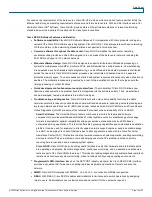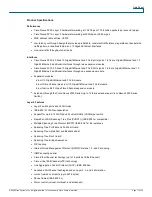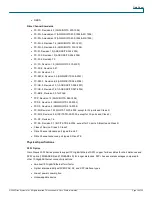
Data Sheet
© 2009 Cisco Systems, Inc. All rights reserved. This document is Cisco Public Information.
Page 10 of 22
Focused on the requirements of the data center, Cisco NX-OS provides a robust and rich feature set that fulfills the
Ethernet and storage networking requirements of present and future data centers. With an XML interface and a CLI
like that of Cisco IOS
®
Software, Cisco NX-OS provides state-of-the-art implementations of relevant networking
standards as well as a variety of true data center-class Cisco innovations.
Cisco NX-OS Software Features and Benefits
●
Software compatibility: Cisco NX-OS Software Release 4.0 interoperates with Cisco products running any
variant of the Cisco IOS Software operating system. Cisco NX-OS 4.1 also interoperates with any networking
OS that conforms to the networking standards listed as supported in this data sheet.
●
Common software throughout the data center: Cisco NX-OS simplifies the data center operating
environment and provides a unified OS designed to run all areas of the data center network, including the
LAN, SAN, and Layer 4 to 7 network services.
●
Modular software design: Cisco NX-OS is designed to support distributed multithreaded processing on
symmetric multiprocessors (SMPs), multicore CPUs, and distributed line-card processors. Computationally
intensive tasks, such as hardware table programming, can be offloaded to dedicated processors distributed
across the line cards. Cisco NX-OS modular processes are instantiated on demand, each in a separate
protected memory space. Thus, processes are started and system resources allocated only when a feature is
enabled. The modular processes are governed by a real-time preemptive scheduler that helps ensure the
timely processing of critical functions.
●
Quick development of enhancements and problem fixes: The modularity of Cisco NX-OS allows new
features, enhancements, and problem fixes to be integrated into the software quickly. Thus, modular fixes
can be developed, tested, and delivered in a short time span.
●
Troubleshooting and diagnostics: Cisco NX-OS is built with unique serviceability functions to enable
network operators to take early action based on network trends and events, enhancing network planning and
improving network operations center (NOC) and vendor response times. Smart Call Home and Cisco Generic
Online Diagnostics (GOLD) are some of the features that enhance the serviceability of Cisco NX-OS.
◦
Smart Call Home: The Smart Call Home feature continuously monitors hardware and software
components to provide email-based notification of critical system events. A versatile range of message
formats is available for optimal compatibility with pager services, standard email, and XML-based
automated parsing applications. This feature offers alert grouping capabilities and customizable destination
profiles. It can be used, for example, to directly page a network support engineer, send an email message
to a NOC, and employ Cisco Auto-Notify services to directly generate a case with the Cisco Technical
Assistance Center (TAC). This feature is a step toward autonomous system operation, enabling networking
devices to inform IT when a problem occurs and helping ensure that the problem is acted on quickly,
reducing time to resolution and increasing system uptime.
◦
Cisco GOLD: Cisco GOLD is a suite of diagnostic facilities to verify that hardware and internal data paths
are operating as designed. Boot-time diagnostics, continuous monitoring, and on-demand and scheduled
tests are part of the Cisco GOLD feature set. This industry-leading diagnostics subsystem allows rapid fault
isolation and continuous system monitoring, critical in today’s continuously operating environments.
●
Programmatic XML interface: Based on the NETCONF industry standard, the Cisco NX-OS XML interface
provides a consistent API for devices, enabling rapid development and creation of tools to enhance the
network.
●
SNMP: Cisco NX-OS complies with SNMPv1, v2, and v3. A rich collection of MIBs is supported.
●
RBAC: With RBAC, Cisco NX-OS enables administrators to limit access to switch operations by assigning
roles to users. Administrators can customize access and restrict it to the users who require it.



